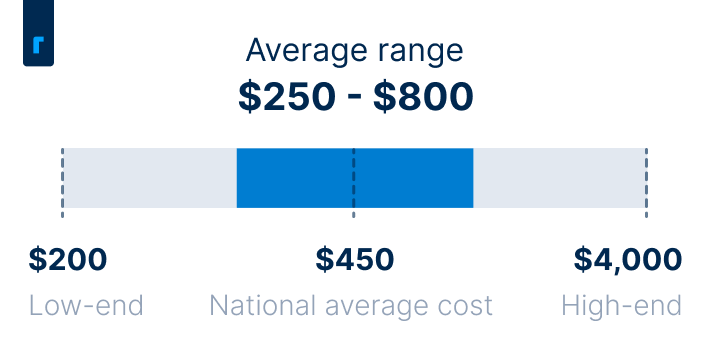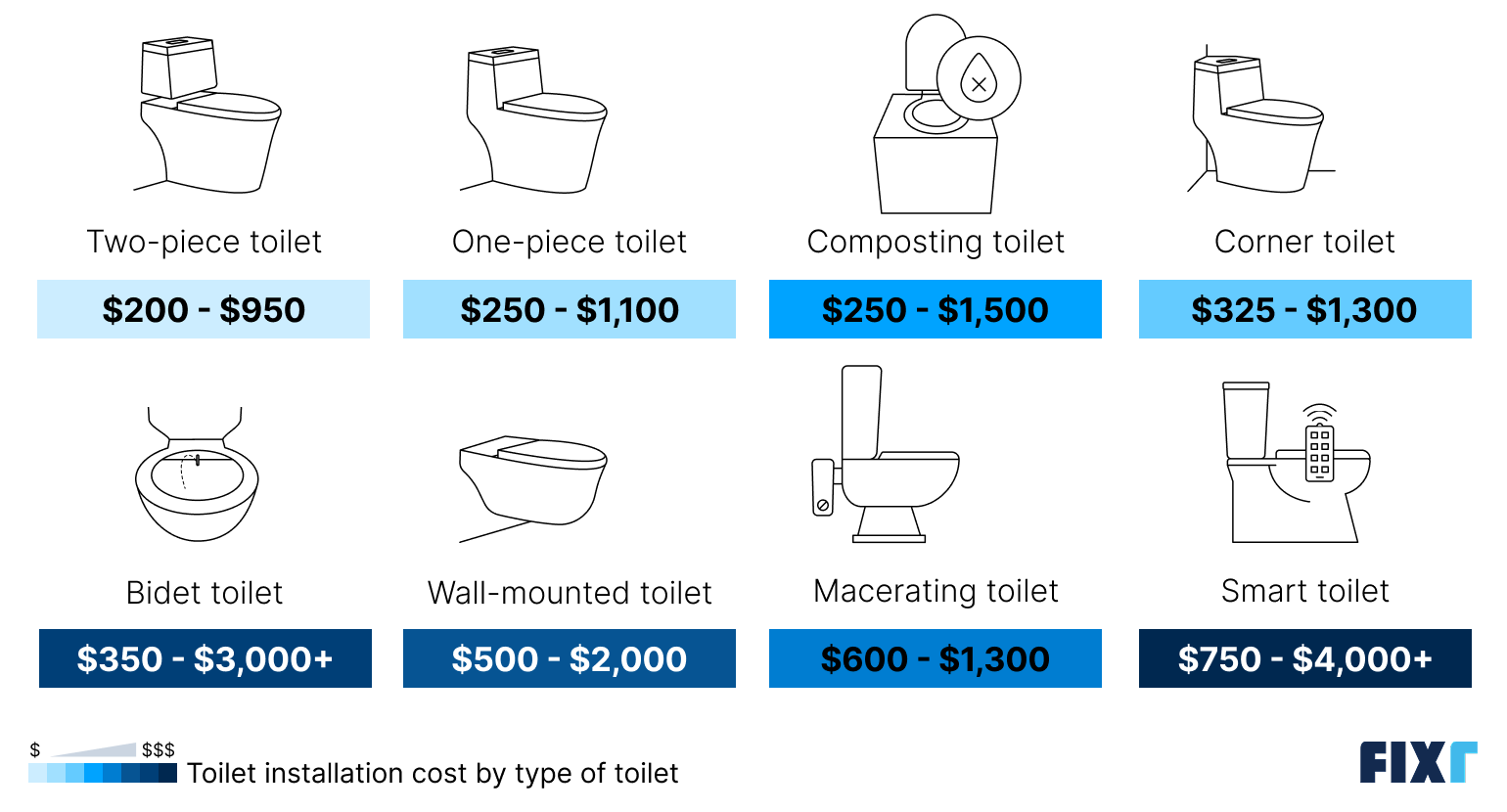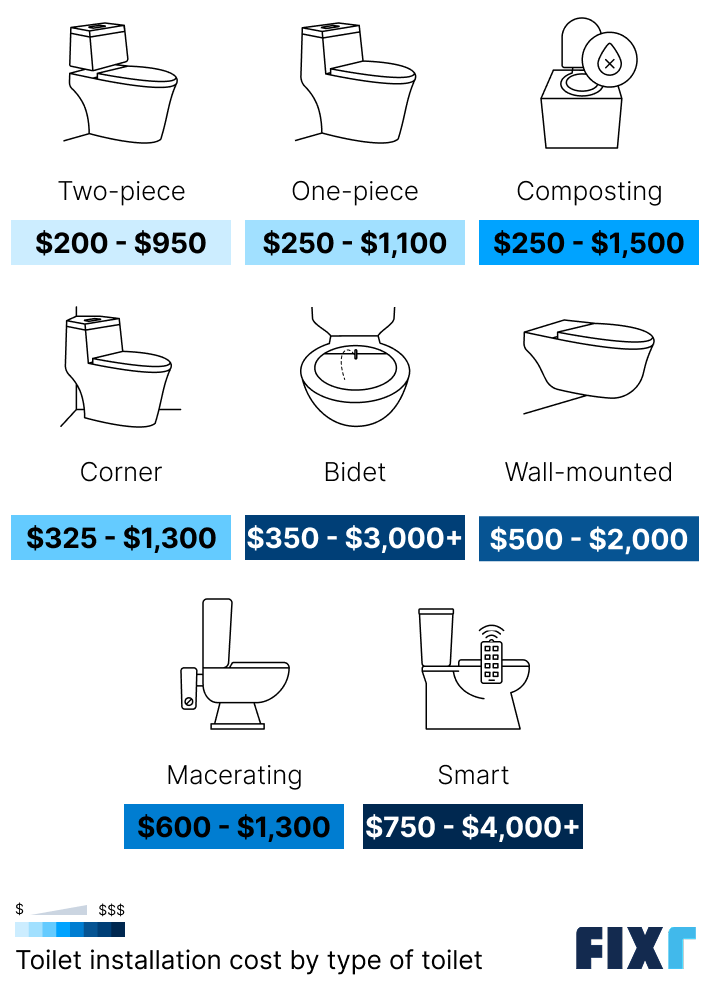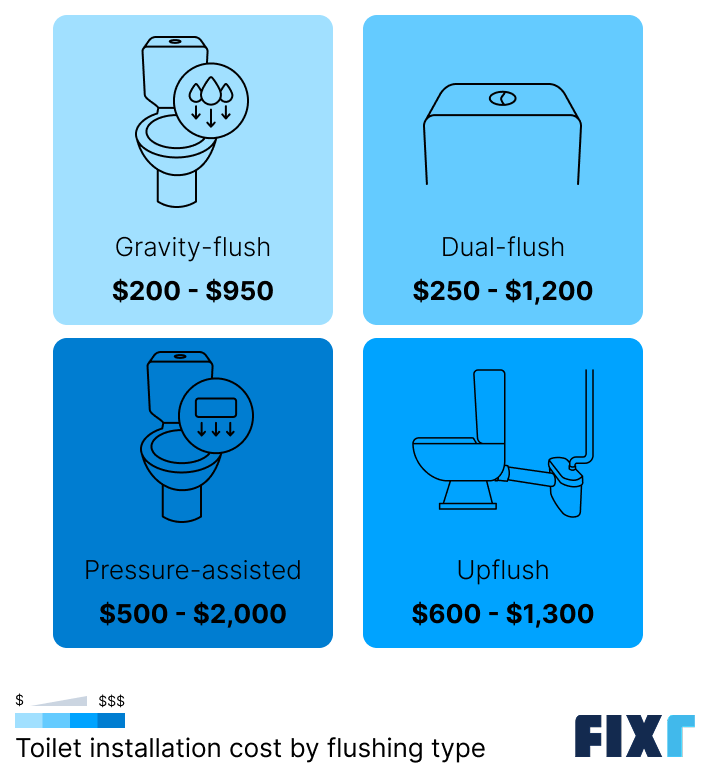Updated: September 11, 2025
Written by Dan Simms
Nieves is a home remodeling editor at Fixr.com with special interest in landscaping, pest control, painting, installation, and repair projects. She brings her work ethic, creativity, and love for teamwork into everything she does, including working with writers and designers at Fixr.com to develop useful and comprehensive guides for homeowners.
Learn moreReviewed by Nieves Martinez
Toilets are absolute necessities in every home, and having one that works properly can help you avoid wasted water, unnecessarily high water bills, frequent clogs, and even leaks that could result in severe property damage and contamination. If you’re thinking of moving soon, replacing your toilet along with other plumbing fixtures in the bathroom can also help you get a higher price for your home.
The average cost to install a toilet is $450, including materials and labor, and most homeowners pay somewhere between $250 and $800. Your costs will depend mostly on the type and quality of the toilet you choose, but necessary changes to your plumbing can also affect your total. You could pay as little as $2,000 for a simple two-piece toilet, but prices can climb as high as $4,000 for high-end toilets with installations that require changes to your utilities.
Average Cost of Toilet Installation


Toilet Installation Costs | |
National average cost | $450 |
Average range | $250 – $800 |
Low-end cost | $200 |
High-end cost | $4,000 |
New Toilet Cost by Type
The type of toilet you choose will have the biggest impact on your toilet installation cost, as well as on the functionality and design you get. Two-piece toilets are the most common, but they take up more space than many other options. One-piece toilets feature a more compact design with an integrated tank, making them superior for smaller bathrooms. Wall-hung toilets are an even better option with a tank hidden in the wall, but replacing another type of toilet with a wall-mounted toilet requires changes to your plumbing and can get expensive. Corner toilets can fit in a corner, potentially opening up the rest of your bathroom layout.
A macerating toilet, sometimes called an upflush toilet, is a common option for basement bathrooms that need to pump waste upward to connect to the main sewer line. Composting toilets are more common in remote areas that don’t have access to a waste management system, like off-grid homes and RVs.
Smart toilets include features like heated seats, bidets, automatic flushing, night lights, and leak and overflow detection. While they’re the most convenient to use, they’re also the most expensive. You can also opt for a bidet toilet to add functionality and comfort without the high smart toilet installation costs.


Type | Installation Cost Range |
Two-piece toilet | $200 – $950 |
One-piece toilet | $250 – $1,100 |
Composting toilet | $250 – $1,500 |
Corner toilet | $325 – $1,300 |
Bidet toilet | $350 – $3,000+ |
Wall-mounted/wall-hung toilet | $500 – $2,000 |
Macerating toilet | $600 – $1,300 |
Smart toilet | $750 – $4,000+ |
Cost of Toilet Installation by Flushing Type
In addition to choosing a type of toilet for your bathroom, you’ll also have some options when it comes to the flushing mechanism.
The most common flush type is the gravity-flush system, which holds water in an upper tank that uses a flapper system to release water down into the bowl that’s fed by gravity.
Dual-flush toilets are similar, but they offer two flush capacities for greater control and water conservation.
Pressure-assisted flushing mechanisms use a pump to help move waste along, which can help reduce water usage and all but eliminate the risk of clogs.
Upflush systems are most common in macerating toilets, as they use a pump to move the waste up into your main sewer line, making this a common option in basement bathrooms where a sump pump isn’t available.
A tower flush system operates similarly to a traditional flapper system, but it uses a tower that lifts the stopper completely away from the bottom of the tank, resulting in improved flow and a reduced risk of clogs. This type is more expensive than a standard gravity-flush system, but it’s less costly of an upgrade than a toilet with pressure assist.


Flushing Type | Installation Cost Range |
Gravity-flush | $200 – $950 |
Dual-flush | $250 – $1,200 |
Pressure-assisted | $500 – $2,000 |
Upflush | $600 – $1,300 |
Labor Cost to Install a Toilet
On average, you should expect to pay between $150 and $440 for labor alone for toilet installation. A professional plumber will include the cost to disconnect your existing fixture and the cost to install the new toilet, including connecting it to the water supply and the waste line. Costs may also include hauling away and dumping the old toilet, but check with your plumber to see if that’s a separate cost. If it’s a separate fee, expect to add $50 to $200 to your total.
Labor costs depend mostly on the job’s complexity. Relocating utility lines or wiring a smart toilet can raise costs, as can choosing a different toilet style or size that requires extra work like re-tiling, drywall, or painting. Plumbers charge $75–$150 per hour, but other pros (painters, carpenters, electricians) all charge different rates.
Toilet Replacement Cost vs. New Toilet Installation Cost
Most homeowners will be replacing an existing toilet when it comes time for the job, and this costs between $250 and $800, in most cases. If you’re installing a toilet where one didn’t exist previously, you can expect to pay far more to route water supply lines and waste lines to the area and connect them to your main lines and plumbing stack.
Installing a toilet for the first time costs between $1,000 and $3,500. Prices can go up from there if you need to make structural changes to accommodate the new toilet. Keep in mind that you’ll also need to account for other installation costs if you’re converting a space to a bathroom.
Additional Cost Considerations
The type of toilet, flushing system, and labor costs create the biggest price swings in toilet installation costs, but there are other factors at play that you should consider to avoid surprise charges.
Brand
The brand of toilet you choose will play a role in your material costs, with brands like Toto and Saniflo driving average toilet installation costs above $1,000, and budget-friendly brands like Delta and American Standard keeping material costs as low as $150. Keep in mind, though, that more expensive brands tend to provide better quality and more long-term value.
Permits
Basic toilet replacements usually don’t need permits, but you’ll likely need one if you’re relocating the toilet or installing it for the first time. Plumbing permits typically cost between $50 and $300, though fees can be higher during a full bathroom remodel.
Installation Timeline
If you only have a single toilet in your home and need an emergency replacement, you’ll very likely have to pay higher labor fees for a rush installation. This can add hundreds to your total, especially if you need the work done on a holiday or a weekend.
Surrounding Repairs
If your new toilet differs in style, size, or requires a wall-mounted tank, expect extra repair costs around the toilet. Simple fixes like a drywall patch can cost $75 to $100, while more extensive work on walls, floors, or fixtures can run into the hundreds.
Bidet Installation
Bidets are becoming more and more popular, so you may want to budget to add one to your bathroom for increased utility and comfort. A standalone bidet costs between $400 and $2,600, while a simple bidet attachment for a standard toilet can add between $40 and $200.
Additional Plumbing and Repairs
During installation, a plumber may encounter several factors that add to your total cost. You may need additional plumbing work if your new toilet doesn't line up with the existing supply or waste lines, or if your plumber discovers unforeseen issues like rotted subfloors or corroded pipes. These can add hundreds of dollars to your total, with plumbers charging between $75 and $150 per hour for the work.
Location
The location of the toilet in your home can slightly affect installation costs. Labor may be higher if the plumber must move the fixture up or down stairs or into tight spaces, and basement toilets often cost more due to upflush systems or macerators needed to reach the sewer line.
Bowl Shape and Height
You may pay extra if you choose a specific bowl shape or seat height. Elongated bowls, which are more modern and popular, typically cost more than standard round bowls. Standard toilet seats range from 14.5 to 16 inches, but taller toilets designed for comfort or to meet ADA standards are 17–19 inches and usually come with a higher price tag.
When to Replace Your Toilet
Replacing your toilet may seem like an unnecessary expense, or one that you can safely put off until there’s a serious issue with your existing one. However, along with obvious signs you need to replace your toilet, there are some less apparent problems to look out for that suggest it’s time to replace your toilet.
Cracks in the porcelain: Visible cracks in your toilet, whether they’re on the bowl, tank, or stand, can lead to leaks over time, which can cause water damage, unsanitary conditions, and other related problems, like mold growth. You should take any visible cracks in the porcelain as a sign that it’s time to replace your toilet.
Visible leaks: You should also consider a replacement if you notice water pooling around the base of your toilet. You can have a plumber take a look to make sure the water isn’t coming from a nearby shower or sink, or simply from the braided hose connecting your toilet to the water supply before you dive into a full toilet replacement.
Frequent clogs: Ongoing issues with clogs can suggest problems with your toilet’s tank or the internal components. Have a plumber clear major clogs and blockages for you, but if you continue running into issues, a replacement might be a more cost-effective option in the long run.
Frequent repairs: You should replace your toilet if you find that you continuously have to carry out toilet repairs, whether they’re for the internal components, the flush system, or something else. This suggests that your toilet is nearing the end of its life.
Running water: A constantly running toilet can waste thousands of gallons of water each year, so it’s important to repair or replace it. You can test for slow leaks by adding a few drops of food coloring to the tank and checking after 30 minutes to see if it seeps into the bowl, since even minor leaks can add up over time.
Instability: Toilets that rock when you sit on them could suggest an issue with the mounting bolts in the floor or the hardware that connects your toilet to them. In either case, a complete replacement might be a good idea, as these problems often start to happen when a toilet reaches the end of its useful life.
Creaking floor: Sudden problems with creaking floorboards around your toilet could suggest that the wooden subfloor or floor joists are rotting or swelling due to a hidden leak. If you notice this issue, it’s worth having a professional check the source of the problem and replace your toilet if it’s the culprit.
Aesthetic or comfort issues: Replacing your toilet can freshen up and modernize the look of your bathroom and improve your comfort, especially if you or a family member has a disability that makes a standard toilet challenging to use.
Even if you don’t have a glaring issue with your existing toilet, installing a new one could make financial sense. Older toilets tend to use more water, up to 6 gallons per flush, while the Environmental Protection Agency (EPA) reports that modern toilets can use as little as 1.28 gallons per flush with minimal or no loss of performance. Based on the EPA’s calculations, upgrading to a toilet with a WaterSense label could save the average home over $3,400.
DIY vs. Hiring a Professional
On average, the labor alone for toilet installation costs between $150 and $440, so you could save hundreds of dollars by doing the work yourself. While it’s feasible to DIY a simple toilet replacement to save some money, it’s usually worthwhile to hire a professional, as mistakes can be very costly.
Any errors while connecting your new fixture to water and sewer lines can lead to leaks and dangerous sewer gases escaping and contaminating your indoor air. It’s possible to make mistakes while maneuvering your toilet into place, and this can lead to damage to the toilet that could require another full replacement if you crack the porcelain.
If you do decide to hire a pro, first check to make sure they hold a plumbing license and carry general and liability insurance. You should also check online reviews to find a reliable plumber in your area, or ask neighbors, friends, or family members for recommendations. Make sure your pro gives you a formal estimate with specific model numbers or serial numbers for the materials they plan to use.
How to Save Money on Toilet Installation Costs
Replacing a toilet can cost more than $4,000 in some cases, but there are a handful of things you can do to keep your total closer to the average of $450 or even below that.
Choose the right type of toilet: The type of toilet you choose plays the biggest role in your costs, so go with a standard two-piece toilet or a more modern one-piece toilet to keep material costs low. Avoid smart toilets and bidet toilets, as these have more functionality but come with much higher price tags.
Consider brand names carefully: Go with a budget-friendly brand like American Standard or Delta to keep material costs as low as possible, but consider long-term value, too. Luxury brands like Toto and Saniflo will drive costs much higher, but mid-tier brands can strike a good balance between upfront cost and long-term performance.
Stick with the same toilet style, size, and shape: Any repairs you need to the surrounding flooring or drywall can add hundreds to your toilet replacement costs. Sticking with the same size and shape and paying particular attention to matching the existing foot dimensions will help avoid unnecessary build-back costs.
Avoid relocating the toilet from its original position: Unless you really need to make changes to your bathroom layout, avoid moving your toilet’s position. Even minor changes can drive up costs, as they require rerouting water supply and waste lines to fit the new location.
Haul away your old toilet yourself: You can save up to $200 by hauling away your old toilet yourself rather than having your plumber handle the additional work. You may need to pay dumping fees, still, but even then, you’ll save money over having a pro dispose of the old fixture.
Think about efficiency: Going with a low-flow or dual-flush toilet can save you money over time on your water bills, which can add up to thousands over the life of the fixtures.
Take advantage of rebates and incentives: Some water companies and local municipalities offer rebates, tax credits, and other incentives if you install a WaterSense-certified toilet.
FAQs
On average, you can expect to pay between $150 and $440 for the labor to replace a toilet. The specific cost will depend on the complexity of the job and can climb higher if you need changes to your plumbing or electrical systems.
Most handymen can handle toilet replacements, but only if you’re replacing an existing toilet with a similar style and size. Changing styles, sizes, or shapes may require changes to your water and waste lines, which would require a certified plumber. Even for standard replacements, it’s best to have a plumber handle the work.
Most professionals can replace a toilet in just an hour or two, but the installation could take up to 4 hours or longer if it’s a more complex job. Some things that can extend the installation timeline include necessary changes to your water supply and waste lines, build-back to the flooring or drywall around your toilet, and electrical work necessary to hardwire a smart toilet.
Most toilets last 10–15 years, with occasional maintenance like replacing the flush kit, seat, flapper, or wax ring, each typically costing under $100. Leaks, cracks, or damage may require earlier replacement, and older toilets may use more water, making an upgrade to a low-flush model a cost-effective option.
